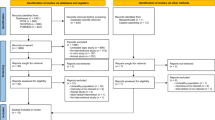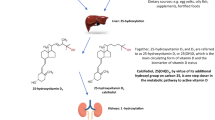Abstract
Purpose
Diabetes Mellitus (DM) is a systemic disease that can effect tissues and their physiological functions at molecular and biochemical levels. Diabetic osteoporosis is one of the chronic diseases of bone metabolism effected by and characterized by augmented risk of osteoporotic fractures and destroying of bone microarchitecture. It was aimed to investigate the alterations in femoral bone structure that may take place as a complication of DM by using the antioxidant properties of eugenol and quercetin, which are phenolic compounds, in streptozotocin nicotinamide (STZ-NA) induced rats as an experimental type 2 DM (T2 DM) model.
Methods
The antioxidant effect of eugenol and quercetin in case of DM development was determined by GSH ELISA kit. The effect of DM on alterations in bone structure was analyzed by micro CT. BMD, Tb.Bv/Tb.Tv, Tb.N, Tb.Th, Ct.Th, Tb.Sp and SMI data were calculated with the software CTAn.
Results
Serum GSH levels, Tb.Th and Tb.Bv/Tb.Tv values statistically decreased, and SMI values statistically increased in diabetic group compared with controls. Serum GSH levels in eugenol group were higher than diabetic group, and Tb.Bv/Tb.Tv values in eugenol group were lower than controls. Quercetin group had higher serum GSH levels and Tb.Th values compared with diabetic group, while SMI values were lower in quercetin group compared with diabetic group.
Conclusion
Eugenol and quercetin were revealed to have antioxidant, antidiabetic and osteoprotective effects on the repair of bone structure in experimental STZ-NA T2 DM model.








Similar content being viewed by others
References
Ma R, Wang L, Zhao B, Liu C, Liu H, et al. Diabetes Perturbs Bone Microarchitecture and Bone Strength through Regulation of Sema3A/IGF-1/β-Catenin in Rats. Cell Physiol Biochem. 2017;41(1):55–66. https://doi.org/10.1159/000455936.
Schwartz AV. Diabetes Mellitus: Does it Affect Bone? Calcif Tissue Int. 2003;73(6):515–9. https://doi.org/10.1007/s00223-003-0023-7.
Brandi ML. Bone health and diabetes Medicographia. 2010;32:364–9.
Nyman JS, Even JL, Jo CH, Herbert EG, Murry MR, et al. Increasing duration of type 1 diabetes perturbs the strength-structure relationship and increases brittleness of bone. Bone. 2011;48(4):733–40. https://doi.org/10.1016/j.bone.2010.12.016.
Kawashima Y, Fritton JC, Yakar S, Epstein S, Schaffler MB, et al. Type 2 Diabetic Mice Demonstrate Slender Long Bones with Increased Fragility Secondary to Increased Osteoclastogenesis. Bone. 2009;44(4):648–55. https://doi.org/10.1016/j.bone.2008.12.012.
Masiello P, Broca C, Gross R, Roye M, Manteghetti M, et al. Experimental NIDDM: development of a new model in adult rats administered streptozotocin and nicotinamide. Diabetes. 1998;47(2):224–9. https://doi.org/10.2337/diab.47.2.224.
Glorie L, Behets GJ, Baerts L, De Meester I, D’Haese PC, et al. DPP IV inhibitor treatment attenuates bone loss and improves mechanical bone strength in male diabetic rats. Am J Physiol Endocrinol Metab. 2014;307(5):E447-455. https://doi.org/10.1152/ajpendo.00217.2014.
Vessal M, Hemmati M, Vasei M. Antidiabetic effects of quercetin in streptozocin-induced diabetic rats. Comp Biochem Physiol C Toxicol Pharmacol. 2003;135C(3):357–64. https://doi.org/10.1016/S1532-0456(03)00140-6.
Eid HM, Nachar A, Thong F, Sweeney G, Haddad PS. The molecular basis of the antidiabetic action of quercetin in cultured skeletal muscle cells and hepatocytes. Phcog Mag. 2015;11(41):74–81. https://doi.org/10.4103/0973-1296.149708.
Al-Trad B, Alkhateeb H, Alsmadi W, Al-Zoubi M. Eugenol ameliorates insulin resistance, oxidative stress and inflammation in high fat-diet/streptozotocin-induced diabetic rat. Life Sci. 2019;216:183–8. https://doi.org/10.1016/j.lfs.2018.11.034.
Vianna AGD, Sanches CP, Barreto FC. Effects of type 2 diabetes therapies on bone metabolism. Diabetol Metab Syndr. 2017;9:75. https://doi.org/10.1186/s13098-017-0274-5.
Usuki S, Ito Y, Morikawa K, Kise M, Ariga T, et al. Effect of pre-germinated brown rice intake on diabetic neuropathy in streptozotocin-induced diabetic rats. Nutr Metab (Lond). 2007;4:25. https://doi.org/10.1186/1743-7075-4-25.
Kalyanaraman H, Schwaerzer G, Ramdani G, Castillo F, Scott BT, et al. Protein Kinase G Activation Reverses Oxidative Stress and Restores Osteoblast Function and Bone Formation in Male Mice With Type 1 Diabetes. Diabetes. 2018;67(4):607–23. https://doi.org/10.2337/db17-0965.
Rubin MR. Skeletal fragility in diabetes. Ann NY Acad Sci. 2017;1402(1):18–30. https://doi.org/10.1111/nyas.13463.
Szkudelski T. Streptozotocin-nicotinamide-induced diabetes in the rat. Characteristics of the experimental model. Exp Biol Med (Maywood). 2012;237(5):481–90. https://doi.org/10.1258/ebm.2012.011372.
Jeong KJ, Kim do Y, Quan HY, Jo HK, Kim GW, et al. Effects of eugenol on hepatic glucose production and AMPK signaling pathway in hepatocytes and C57BL/6J mice. Fitoterapia. 2014;93:150–62. https://doi.org/10.1016/j.fitote.2013.12.023.
Torres-Piedra M, Ortiz-Andrade R, Villalobos-Molina R, Singh N, Medina-Franco JL, et al. A comparative study of flavonoid analogues on streptozotocin-nicotinamide induced diabetic rats: quercetin as a potential antidiabetic agent acting via 11beta-hydroxysteroid dehydrogenase type 1 inhibition. Eur J Med Chem. 2010;45(6):2606–12. https://doi.org/10.1016/j.ejmech.2010.02.049.
Coskun O, Kanter M, Korkmaz A, Oter S. Quercetin, a flavonoid antioxidant, prevents and protects streptozotocin-induced oxidative stress and beta-cell damage in rat pancreas. Pharmacol Res. 2005;51(2):117–23. https://doi.org/10.1016/j.phrs.2004.06.002.
Dias AS, Porawski M, Alonso M, Marroni N, Collado PS, et al. Quercetin decreases oxidative stress, NF-kappaB activation, and iNOS overexpression in liver of streptozotocin-induced diabetic rats. J Nutr. 2005;135(10):2299–304. https://doi.org/10.1093/jn/135.10.2299.
Sanae F, Kamiyama O, Ikeda-Obatake K, Higashi Y, Asano N, et al. Effects of eugenol-reduced clove extract on glycogen phosphorylase b and the development of diabetes in db/db mice. Food Funct. 2014;5(2):214–9. https://doi.org/10.1039/C3FO60514K.
Dokumacioglu E, Iskender H, Sen TM, Ince I, Dokumacioglu A, et al. The effects of hesperidin and quercetin on serum tumor necrosis factor-alpha and interleukin-6 levels in streptozotocin-induced diabetes model. Phcog Mag. 2018;14:167–73. https://doi.org/10.4103/pm.pm_41_17.
Soliman GZA. Blood lipid peroxidation (superoxide dismutase, malondialdehyde, glutathione) levels in Egyptian type 2 diabetic patients. Singapore Med J. 2008;49(2):129–36.
Perez Castrillon JL, Riancho Moral JA, De Luis D, Caeiro Rey JR, Guede Rodríguez D, et al. Structural study using micro-CT of the femur of Goto-Kakizaki rats, experimental model for non-overweight type 2 diabetes. Rev Osteoporos Metab Miner. 2011;3(2):95–100.
Pereira M, Gohin S, Lund N, Hvid A, Smitham PJ, et al. Sclerostin does not play a major role in the pathogenesis of skeletal complications in type 2 diabetes mellitus. Osteoporos Int. 2017;28(1):309–20. https://doi.org/10.1007/s00198-016-3718-0.
Kanter M, Altan MF, Donmez S, Ocakci A, Kartal ME. The effects of quercetin on bone minerals, biomechanical behavior, and structure in streptozotocin-induced diabetic rats. Cell Biochem Funct. 2007;25(6):747–52. https://doi.org/10.1002/cbf.1397.
Liang W, Luo Z, Ge S, Li M, Du J, et al. Oral administration of quercetin inhibits bone loss in rat model of diabetic osteopenia. Eur J Pharmacol. 2011;670(1):317–24. https://doi.org/10.1016/j.ejphar.2011.08.014.
Niu YB, Yang YY, Xiao X, Sun Y, Zhou YM, et al. Quercetin prevents bone loss in hindlimb suspension mice via stanniocalcin 1-mediated inhibition of osteoclastogenesis. Acta Pharmacol Sin. 2020;41(11):1476–86. https://doi.org/10.1038/s41401-020-00509-z.
Abuohashish HM, Khairy DA, Abdelsalam MM, Alsayyah A, Ahmed MM, et al. In-vivo assessment of the osteo-protective effects of eugenol in alveolar bone tissues. Biomed Pharmacother. 2018;97:1303–10. https://doi.org/10.1016/j.biopha.2017.11.068.
Hua Y, Bi R, Li Z, Li Y. Resveratrol treatment promotes titanium implant osseointegration in diabetes mellitus rats. J Orthop Res. 2020;38(10):2113–9. https://doi.org/10.1002/jor.24651.
Zeitoun D, Caliaperoumal G, Bensidhoum M, Constans JM, Anagnostou F, Bousson V. Microcomputed tomography of the femur of diabetic rats: alterations of trabecular and cortical bone microarchitecture and vasculature-a feasibility study. Eur Radiol Exp. 2019;3(1):17. https://doi.org/10.1186/s41747-019-0094-5.
Huang YY, Wang ZH, Deng LH, Wang H, Zheng Q. Oral Administration of Quercetin or Its Derivatives Inhibit Bone Loss in Animal Model of Osteoporosis. Oxid Med Cell Longev. 2020;Vol.2020, Article ID 6080597, 21 pages. https://doi.org/10.1155/2020/6080597
Acknowledgements
This study was supported by the Scientific Research Projects Unit of Istanbul University with the project number 22448. The authors report no conflict of interest.
Author information
Authors and Affiliations
Corresponding author
Ethics declarations
Competing Interests
The authors declare that they have no confict of interest.
Additional information
Publisher's note
Springer Nature remains neutral with regard to jurisdictional claims in published maps and institutional affiliations.
Rights and permissions
About this article
Cite this article
Baş, A., Albeniz, I. Investigation of the effects of eugenol and quercetin on bone loss in STZ-NA induced diabetic rats utilizing micro CT. J Diabetes Metab Disord 21, 637–646 (2022). https://doi.org/10.1007/s40200-022-01026-y
Received:
Accepted:
Published:
Issue Date:
DOI: https://doi.org/10.1007/s40200-022-01026-y




